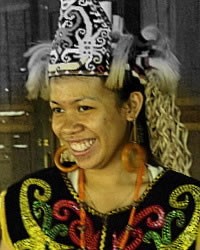Kenyah, Western in Malaysia

Photo Source:
MySabah.com
Used with permission
|
Send Joshua Project a map of this people group.
|
| People Name: | Kenyah, Western |
| Country: | Malaysia |
| 10/40 Window: | Yes |
| Population: | 3,800 |
| World Population: | 5,700 |
| Primary Language: | Uma' Lasan |
| Primary Religion: | Christianity |
| Christian Adherents: | 60.00 % |
| Evangelicals: | 5.00 % |
| Scripture: | Translation Started |
| Ministry Resources: | No |
| Jesus Film: | No |
| Audio Recordings: | Yes |
| People Cluster: | Borneo-Kalimantan |
| Affinity Bloc: | Malay Peoples |
| Progress Level: |
|
Introduction / History
Located in the high interior areas of Sarawak State and West Kalimantan live a people who call themselves Kenyah. They comprise over forty divisions and live in more than 110 communities. One of the Upriver peoples, they usually live near river headwaters along the lower and upper reaches of the Baram and Balui Rivers, as well as in big coastal towns such as Miri, Bintulu and Kuching.
The fiber which seems to bind the Kenyah peoples together is the word "Kenyah," which itself isn't a Kenyah word but a Ga'ai-Kayan one meaning 'upriver people'. Only certain groups are able to understand each other's dialects, while others are quite unintelligible. The differences brought about by the many dialects have divided the Kenyah peoples into several groups with varying histories. One of these is the Western Kenyahs. They live in Malaysia and Indonesia and speak Uma' Lasan.
What Are Their Lives Like?
Western Kenyahs cultivate dry rice in jungle clearings as their main source of livelihood. Their swidden rice agriculture, supplemented by hunting, fishing and gathering is a common feature of Kenyah society. Wage labor and cash crops are now becoming important additions to their economy as areas become more accessible for trade.
The Kenyah traditionally lived in villages comprised of multiple longhouses. Kenyah villages are almost exclusively located at the confluence of two rivers, providing easy access to current and future farmland since transportation is by river or foot.
The Kenyah have three social classes. These classes are the paren 'aristocrats', the panyen 'commoners', and the panyen amin or lipen 'slaves'. The paren exercise leadership in Kenyah communities and the panyen form the majority of the population. Many Kenyah traditions are still strong, but the practice of elongated earlobes is dying out. This used to be the most distinguishing feature of Kenyah women. The younger generation of educated Kenyah is migrating to urban areas in search of outside employment.
What Are Their Beliefs?
In pre-modern times, the Kenyah all adhered to traditional animism. Even though there has been a Kenyah conception of a Creator God, Penyelung Agung, the deity responsible for creating the world, was given little importance in day-to-day ritual matters. Instead, there were a multitude of spirits, each with their own characteristics and responsibilities, whom Kenyahs believed intervened in human affairs. Traditional animism and the Bungan cult are nowadays rarely practiced.
Although a minority of Kenyah groups are followers of Islam, the overwhelming majority of Kenyah communities have accepted Christianity. However, some traditional Kenyah animistic beliefs have taken root in the church.
What Are Their Needs?
The Kenyah possess skills and abilities that can be developed for twenty-first-century living. They require professional management of small-scale industries to help improve their livelihoods. This may help younger generations from migrating to urban areas. Additional research of their language and cultural diversity will provide understanding important for translating the good news appropriately for them.
Prayer Points
Pray that local believers will have a burden to assist them with opportunities such as developing home industries that will help Kenyahs gain a better standard of living.
Pray for Kenyahs to put their faith into action by reaching others for Christ.
Pray that the Lord will bless them spiritually and physically in the years to come.